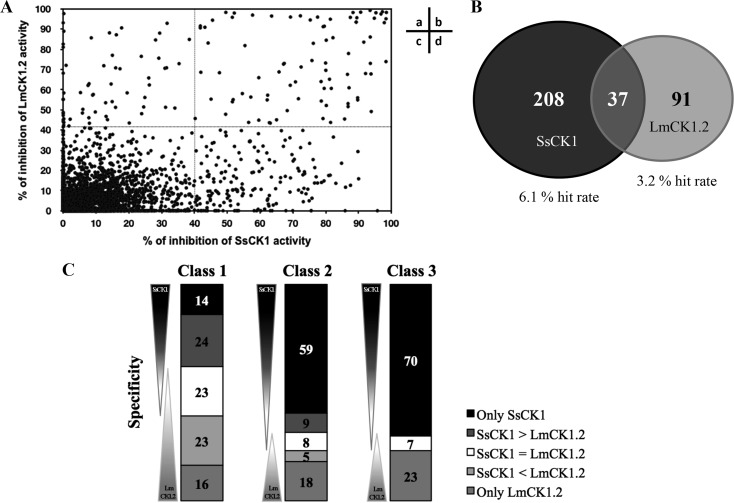FIG 1.
Differential target-based screen of 4,030 compounds from various libraries. (A) Representation of the percentage of inhibition toward LmCK1.2 activity versus the percentage of inhibition toward SsCK1 activity. The compounds in sectors a and b are potent toward LmCK1.2 since they show more than 40% inhibition, whereas the compounds in sectors b and d are potent toward SsCK1. (B) A total of 336 hit compounds were identified in the screen, of which 245 inhibit SsCK1 (6.1% hit rate) and 128 inhibit LmCK1.2 (3.2% hit rate). Only 37 compounds showed equal potency against both CK1s. (C) Compounds were classified according to their specificity: compounds only potent against SsCK1 (only SsCK1), more potent against SsCK1 than LmCK1.2 (SsCK1 > LmaCK1.2), equally potent on both kinases (SsCK1 = LmCK1.2), more potent against LmCK1.2 than SsCK1 (SsCK1 < LmaCK1.2), and only potent on LmCK1.2 (only LmCK1.2). Compounds were also classified according to their percent inhibition: class 1 corresponds to compounds that inhibit the kinase activity between 80 and 100%, class 2 corresponds to compounds that inhibit the kinase activity between 60 and 80%, and class 3 corresponds to compounds that inhibit the kinase activity between 40 and 60%. A total of 23 compounds were more potent toward LmCK1.2 than SsCK1, and 68 compounds were specific to LmCK1.2 (the numbers in the histograms indicate the percentage of compounds in each category).

